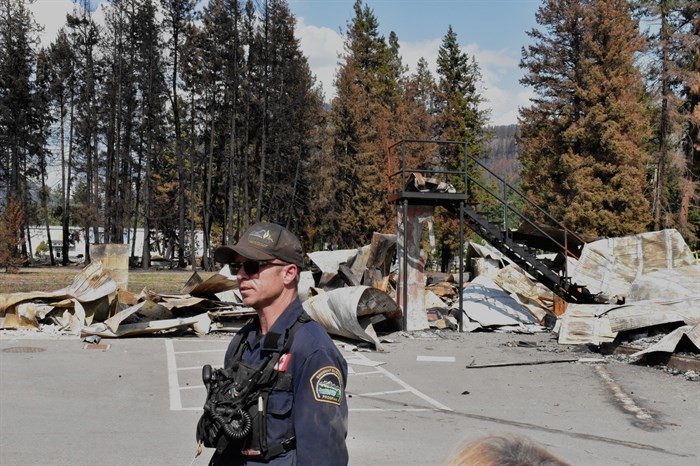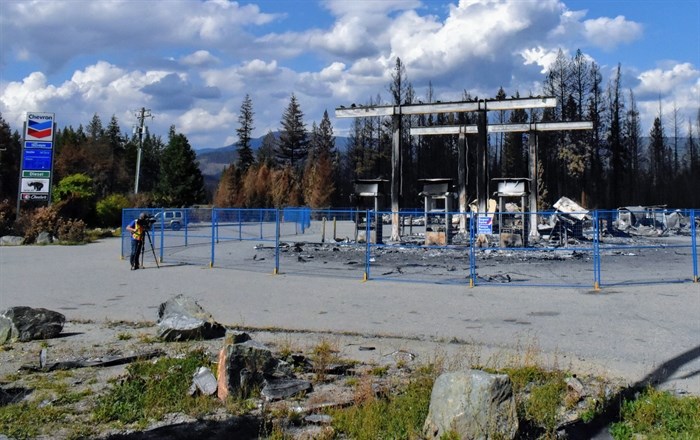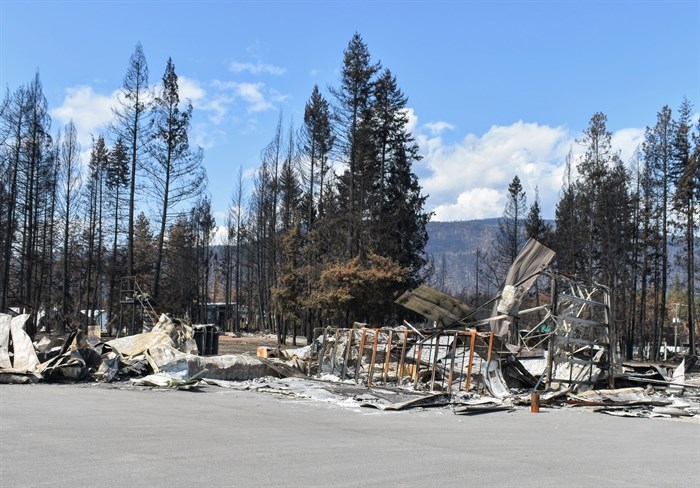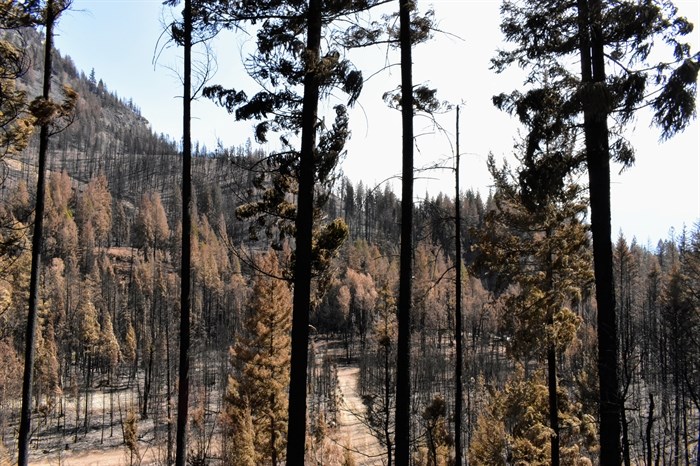
Fire captain Brian Dalgliesh speaks to reporters in front of what remains of the Scotch Creek fire hall on Sept. 6, 2023.
(LEVI LANDRY / iNFOnews.ca)
September 07, 2023 - 6:00 PM
More than 10,000 North Shuswap residents were allowed to return to their properties yesterday after a wildfire swept across the area last month, razing at least 176 homes.
They were forced to evacuate as two wildfires near Adams Lake merged in mid-August, then spread quickly toward rural communities like Lee Creek, Scotch Creek and Squilax.
A convoy of reporters were toured through the area yesterday, Sept. 6, and stopped at two locations, less than a couple hours before the residents' return.
The blackened destruction was obvious immediately after crossing Squilax Bridge, where a gas station is now left in rubble and only the Chevron sign remains.
Only charred trees remain on either side of Anglemont-Squilax Road while driving toward the Adams River crossing.

A gas station near Squilax was razed after the Bush Creek East wildfire swept through the area last month.
(LEVI LANDRY / iNFOnews.ca)
Much of Lee Creek appears to have been spared, however, as wildfire crews kept the blaze away from homes near the lakefront. In Scotch Creek, homes and structures looked to be burned sporadically, with the remains of barely-discernible buildings left behind on some properties.
One of those was the local fire hall, which was destroyed in the midst of a fast-spreading wildfire.
"It was an intense night," Scotch Creek/Lee Creek fire captain Brian Dalgliesh said. "Once we decided it was time to leave the (Scotch Creek) bridge, we came over here and we had a wall of flames coming up behind our hall."
He said fire crews were on the opposite side of the building and were forced to flee as it overtook the fire hall.
"I couldn't even describe. It was like there was no end to it," Dalgliesh said when asked about the size of the oncoming blaze. "A couple of us were in vehicles and it felt like we were inside an oven."
They're now operating out of a temporary building as the Columbia Shuswap Regional District plans its rebuild.
The wildfire destroyed 176 homes, regional district spokesperson Tim Conrad said.

The Scotch Creek fire hall is barely recognizable as little but a charred overhead door and a staircase remain standing.
(LEVI LANDRY / iNFOnews.ca)
Now that nearly all of the wide-ranging evacuation orders are lifted, only individual properties will be restricted from access. Those are properties that haven't been assessed for danger, so Conrad said the regional district isn't ready to allow people to return yet.
The regional district is urging people who are returning to remain on their properties or others that are known to be safe, as venturing into the burned forest can be dangerous.
Although there don't appear to be hotspots on the north side of Shuswap Lake, Conrad said there can be smouldering pockets of ash that can burn people who walk through them. Even more dangerous is the potential for ash pits, which can not only also continue to smoulder into the winter, but could be deep enough to swallow a person who falls in.
"Of course everybody's going to be curious. Everybody's going to want to go for a walk. I'm happy to see my community coming back, but there's still a lot of dangerous stuff out here," Dalgliesh said. "We've got trees, we've got ash pits — there's still a lot of unknowns out here. To anybody coming in, I'd just like to say please don't go for a walk."
Local firefighters are patrolling locally to seek out hot spots and danger trees. For hot spots and flare ups, Dalgliesh said it's "not a matter of if, but when."
Meanwhile, wildfire crews are also continuing to monitor the area for potential flare ups and will work to extinguish them if they appear, but it's the south side above Sorrento where smoke could be seen on ridges and helicopters dropped buckets of water on Sept. 6.
"We need lots of rain or winter to help us out in ensuring this fire is out, but I think we're on the other side of things now," Conrad said. "Barring any ridiculous weather coming our way, we should be OK."
When the Bush Creek East wildfire swept through the area, residents were forced to leave quickly. Some fled in their vehicles toward Highway 1, others were forced to travel north toward the remote community of Seymour Arm and others even fled by boat.

The valley surrounding Scotch Creek just north of the community was torched as the aggressive wildfire left almost no trees untouched.
(LEVI LANDRY / iNFOnews.ca)
Some, however, chose to stay behind and protect their properties, causing tensions between authorities and area residents.
BC Wildfire Service warned them they were interfering with firefighting activity, while area residents defended their actions and people outside the area even tried to push through police blockades to give supplies.
Wildfire equipment was even stolen so people could protect their own homes, Conrad said. Firefighters triage where that equipment can be used best to fight the fire and, despite that, even local firefighters lost their own homes while they tried to defend the community.
"It's common for some people to stay behind and fight the fire, but we also need them to know if they are staying behind to do that, they are agreeing that they're going to self-sustain on their own properties," he said. "We do not provide services into evacuation order areas."
Conrad urged people who make those decisions in the future to volunteer with their local fire department if they want to help defend their community.
The Bush Creek East wildfire is suspected to have been caused by lightning on July 12 and has since grown to 43,000 hectares.
It started on the east side of Adams Lake and merged with the East Adams Lake wildfire in August as they both spread south toward the Shuswap communities.
Thousands of residents in the area remain on evacuation alert, but cooler weather has quieted wildfire activity in the last week.
To contact a reporter for this story, email Levi Landry or call 250-819-3723 or email the editor. You can also submit photos, videos or news tips to the newsroom and be entered to win a monthly prize draw.
We welcome your comments and opinions on our stories but play nice. We won't censor or delete comments unless they contain off-topic statements or links, unnecessary vulgarity, false facts, spam or obviously fake profiles. If you have any concerns about what you see in comments, email the editor in the link above. SUBSCRIBE to our awesome newsletter here.
News from © iNFOnews, 2023